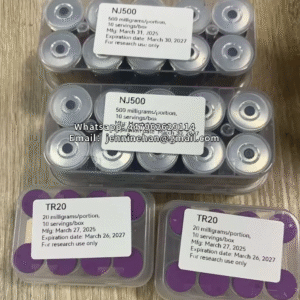Semaglutide 15mg: A Comprehensive Product Overview
Introduction
Semaglutide 15mg is a breakthrough medication in the management of type 2 diabetes and chronic weight management. As a glucagon-like peptide-1 (GLP-1) receptor agonist, it mimics the effects of the natural incretin hormone, enhancing insulin secretion, suppressing glucagon release, and slowing gastric emptying. This leads to improved glycemic control and significant weight loss in patients.
Approved by regulatory bodies such as the FDA and EMA, semaglutide has gained widespread recognition for its efficacy, safety, and convenience as a once-weekly injectable or daily oral formulation. The 15mg dosage represents a higher-strength option, primarily used in weight management under medical supervision.
Mechanism of Action
Semaglutide works by:
-
Stimulating Insulin Secretion: It enhances glucose-dependent insulin release from pancreatic beta cells, reducing postprandial hyperglycemia.
-
Inhibiting Glucagon Release: By suppressing glucagon (a hormone that raises blood sugar), it prevents excessive glucose production in the liver.
-
Delaying Gastric Emptying: Slower digestion promotes prolonged satiety, reducing caloric intake and aiding weight loss.
-
Central Appetite Suppression: It acts on brain receptors to decrease hunger signals, contributing to reduced food cravings.
These combined effects make semaglutide 15mg highly effective for both glycemic control and sustainable weight reduction.
Indications & Uses
1. Type 2 Diabetes Management
Semaglutide 15mg is prescribed as an adjunct to diet and exercise to improve glycemic control in adults with type 2 diabetes. It is particularly beneficial for patients who have not achieved desired glucose levels with other antidiabetic medications.
2. Chronic Weight Management
In higher doses (such as 15mg), semaglutide is approved for obesity treatment in adults with:
-
A BMI ≥30 kg/m² (obesity)
-
A BMI ≥27 kg/m² (overweight) with at least one weight-related comorbidity (e.g., hypertension, dyslipidemia, or cardiovascular disease)
Clinical trials, such as the STEP program, demonstrated an average weight loss of 15-20% over 68 weeks when combined with lifestyle modifications.
Dosage & Administration
-
Formulations: Available as a subcutaneous injection (Ozempic®, Wegovy®) or oral tablet (Rybelsus®).
-
Dosage Escalation: To minimize gastrointestinal side effects, dosing typically starts at 0.25mg/week, gradually increasing to 15mg over several weeks.
-
Administration:
-
Injections: Administered once weekly in the abdomen, thigh, or upper arm.
-
Oral Tablet: Taken once daily on an empty stomach with a small sip of water.
-
Patients should follow their healthcare provider’s instructions carefully to optimize efficacy and tolerability.
Clinical Efficacy & Benefits
1. Superior Glycemic Control
-
Reduces HbA1c by 1.0–1.8%, outperforming many other GLP-1 RAs and insulin therapies.
-
Lowers fasting and postprandial glucose levels effectively.
2. Significant Weight Loss
-
In the STEP trials, patients lost an average of 15-20% of body weight at higher doses (2.4mg–15mg).
-
Reduces visceral fat, improving metabolic health.
3. Cardiovascular Benefits
-
Proven to lower major adverse cardiovascular events (MACE) in high-risk patients.
-
Reduces blood pressure and improves lipid profiles.
4. Convenience & Compliance
-
Once-weekly dosing improves adherence compared to daily medications.
-
Oral formulation (Rybelsus®) offers an alternative for needle-averse patients.

Safety & Side Effects
Semaglutide is generally well-tolerated, but common side effects include:
-
Gastrointestinal: Nausea (~20%), vomiting, diarrhea, constipation (usually transient).
-
Hypoglycemia: Low risk when used alone but possible with insulin or sulfonylureas.
-
Pancreatitis & Gallbladder Issues: Rare but require medical attention if severe abdominal pain occurs.
-
Thyroid C-Cell Tumor Risk: Contraindicated in patients with a personal/family history of medullary thyroid carcinoma (MTC) or Multiple Endocrine Neoplasia syndrome type 2 (MEN 2).
Patients should be monitored for these effects, especially during dose escalation.
Comparison with Other GLP-1 Agonists
| Feature | Semaglutide 15mg | Liraglutide (Saxenda®) | Dulaglutide (Trulicity®) |
|---|---|---|---|
| Dosing Frequency | Once weekly | Daily | Once weekly |
| Weight Loss Efficacy | 15-20% | 5-10% | 3-5% |
| HbA1c Reduction | 1.0–1.8% | 0.8–1.5% | 0.8–1.6% |
| Cardiovascular Benefit | Yes (proven) | Limited | Yes (proven) |
Semaglutide stands out due to its superior weight loss and strong glycemic control, making it a preferred choice among GLP-1 RAs.
Patient Considerations
Who Should Use Semaglutide 15mg?
-
Adults with uncontrolled type 2 diabetes despite other treatments.
-
Individuals with obesity or overweight with comorbidities seeking medical weight loss.
Who Should Avoid It?
-
Patients with personal/family history of MTC or MEN 2.
-
Those with severe gastrointestinal diseases (e.g., gastroparesis).
-
Pregnant or breastfeeding women (limited safety data).

